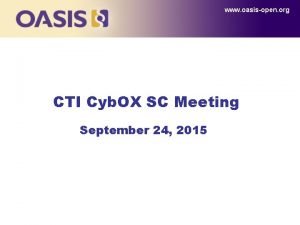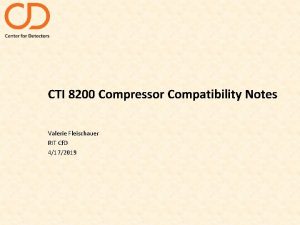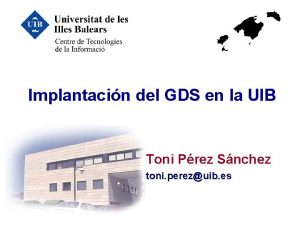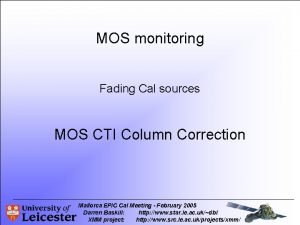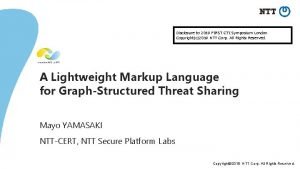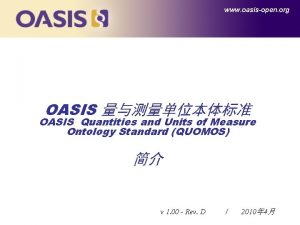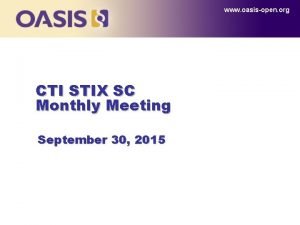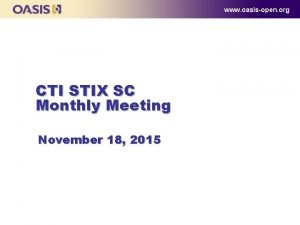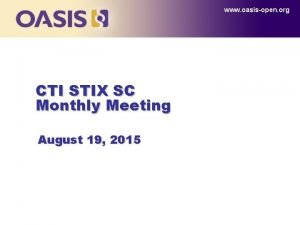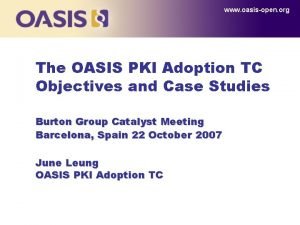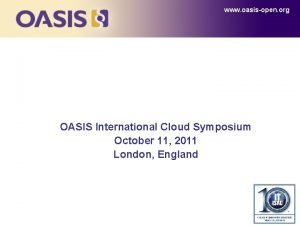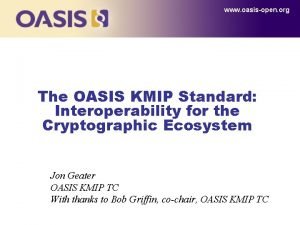www oasisopen org OASIS CTI F 2 F
















- Slides: 16

www. oasis-open. org OASIS CTI F 2 F – Cyb. OX Session 1 January 14, 2016

www. oasis-open. org Ch-ch-changes

Cyb. OX overview: history Initial driver: need for a standard to characterize cyber observables Standard was developed in an ad-hoc fashion to address evolving use cases Informed by MAEC, STIX, DFAX, and others Organic (resource-constrained) development led to divergent architecture With the benefit of hindsight and the shared experience of implementers, numerous deficits have come to light

Cyb. OX overview: challenges ”We have a taxonomy gap!”

Cyb. OX 3. 0 Design Philosophy • Focus: simplification, reducing duplicate mechanisms • Prioritizing refactoring of most-commonly used Cyb. OX Objects • Primary design consideration: backward-compatiblebreaking changes now, stability for the foreseeable future: • New Cyb. OX Objects will be added in sequential point releases targeting specific use cases, in service to community demand, building on a cohesive foundational rethinking of Cyb. OX base constructs • Cyb. OX 3. 0 base constructs will be architected with care to forestall impacting backward-compatibility in additive point releases

Cyb. OX 3. 0: Don’t bite off more than you can chew! • Refactoring and fixing issues with all existing Cyb. OX objects in a single release is not achievable in a meaningful timeframe to address the pain currently experienced by the community • Pragmatic approach: focus on a core set of Cyb. OX Objects for the 3. 0 release • Meet the ≈80% need ASAP, iterate quickly from there…

Cyb. OX overview: ongoing refactoring approach Quantitative analysis: cti-stats A picture’s worth a thousand pull-requests

Cyb. OX Design: Object Hierarchy

Cyb. OX Design: Object Hierarchy https: //github. com/Cyb. OXProject/schemas/wiki/Cyb. OX-Design: -Object-Hierarchy-Structuring Key Issue: how should the Cyb. OX Object hierarchy be designed? Current parent/child (sub-class) based approach has several issues Excessive subclassing Inconsistency Instance content restriction Open Questions Does it make sense to organize Objects around a separate Extension structure? Or should we follow the more granular (non sub-class) philosophy of extensions, but instead define them as separate Objects using the existing structure? E. g. , an NTFS File Object vs. an NTFS File Extension

Address Object Refactoring https: //github. com/Cyb. OXProject/schemas/wiki/Cyb. OX-3. 0: -Address-Object-Refactoring Cyb. OX 2. 1 Address Cyb. OX 3. 0 IP Address IPv 4 Address IPv 6 Address MAC Address Email Address Open Questions Should CIDR be the only supported notation for IP addresses? How should IP addresses be modeled? Should IPv 4/IPv 6 be an extension of IP Address?

File Object Refactoring https: //github. com/Cyb. OXProject/schemas/wiki/Cyb. OX-3. 0: -File-Object-Refactoring Open Questions What default extensions make sense? Should File encompass other file-like Objects? Pipe Socket … Default Extensions File Metadata EXT 3 File NTFS File Image File PDF File Archive File PE Binary File …

Cyb. OX Design: Obj. Relationships

Cyb. OX Design: Object Relationships? https: //github. com/Cyb. OXProject/schemas/wiki/Cyb. OX-Design: -Relationships-vs. -Embedded-Objects Key Issue Relationships between Objects can be expressed in two different ways Directly embedded via Fields Indirectly via an Object Relationship For the sake of simplicity (“one way of doing things”) we should use a single approach Open Questions Does it make sense to express Object <-- --> Object relationships ONLY via an explicit Relationship construct? How should the corner case of relationships between Object Types and other Objects be handled? How should we deal with Objects such as the Socket Address that are exclusively defined based on other Objects?

Just the facts, ma’am… Ongoing debate about where patterning should live… There’s a prevalent notion that Cyb. OX should be the alphabet and that other related standards should define the semantic context. Just food for thought…

Iterating: point releases Mobile Objects Android i. OS SCADA Objects Additional Layer 7 Objects FTP SMTP IRC TAXII over TOR Document File Objects OLE DOC PPT DOCX Comprehensive network forensics Comprehensive endpoint forensics …

Going deeper down the rabbit hole… Proposal: a week-long F 2 F focused on Cyb. OX extension, in collaboration with DFAX, MAEC, and other non-OASIS stakeholders sometime Q 3 2016?


